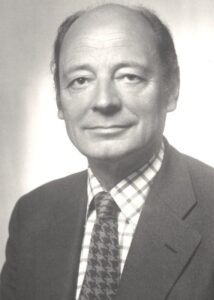In the articles I write on this website, I have many times put forward several definitions from different perspectives for futures studies. This is a sign that futures studies is a very complex concept, because it can be defined from different points of view. An approach that I have always endorsed and emphasized in my writings is an approach that is called “reflective futures studies”. Reflective futurists in most cases are looking for a correct, deep, accurate and complete understanding of the phenomenon in question at the present time. For these people, achieving a deep and accurate understanding is much more attainable and useful than accurately predicting the future, which is impossible in many cases. So, the question is how to get a deep and correct understanding of a phenomenon? The answer to this question was given years ago by Pierre Wack, one of the pioneers of future research with the scenario writing method in Shell Oil Company.

Pierre Wack
His answer in a short sentence is that “if your seeing is perfect and complete, in a correct scale of observation, there is an immediate understanding”.
In Pierre Wack’s view, the most important factor to achieve deep understanding is to have the right scale of observation. Now the next question arises, what is meant by the correct scale of observation or, in general, the scale of seeing?
We all intuitively have a definition of scale in our minds. In this definition, scale is more associated with the concept of distance. That is, the distance between the observer and the observed system or phenomenon. But in futures studies, the meaning of seeing and observing a phenomenon is not to physically see with the eyes in most cases, but to focus on the desired phenomenon and related and influencing factors. The scale of observation refers more to the way in which the phenomenon or system in question is interpreted from a close or distant perspective.

The scale in futures studies is mostly the result of the interpretation process. When we pay attention to a phenomenon or system and intend to describe and interpret it, our mind scans the existing interpretations about that phenomenon or system. Selects one or more interpretations. In each round of interpretation, the raw information is combined with information related to the initial interpretation. Simultaneously, our minds look for patterns that match newly incorporated information with past experiences and learned notions. After the pattern or patterns are found, the combined information and patterns are no longer abstract and have gained meaning in our minds. Scale determines the selecting all initial interpretations, raw data and later additions and combining them all based on existing patterns. Scale, then, is a characteristic of the way in which an observer looks at the outline of a system. Once the scale of observation is established in our minds, then a boundary is drawn between the system in question and its surroundings. That is, we know which information/descriptive/interpretive information is relevant and which are unrelated or have a low degree of relevance. The drawing of these abstract boundaries in people’s minds, which mostly happens unconsciously, can mean life and death for the decision makers and managers of an organization. That is, it is possible that the decision-makers and managers, on an incorrect scale, recognize very important and vital information outside the border of importance and relevance and are indifferent to them, which will have no result other than crisis and strategic shock. There are subtleties to scale that are hard to pin down. In some cases, the scale is related to the number of items selected by the researcher to describe, interpret and analyze. In other cases, it is related to the symbols, words and metaphors chosen to describe and interpret and in general the language used. That is, the variety of symbols, words and metaphors for explanation is determined by the scale. In other cases, it is related to the levels and hierarchies of explanation and interpretation. In 1972, Philip Warren Anderson published an article in the Science that became the basis of emergence and complexity theory. The title of the article was “More is Different”.

Philip Warren Anderson
In this article, he says that when you look at the quantum world and inside the atom, you see a world with its own rules, but these rules do not prevail in the world of molecules and cells (which are themselves composed of atoms). And in the same way, the world of the body and body of living beings and humans, which are made up of cells and molecules, also have different rules than the molecules and cells themselves, and the world of society and social sciences, which are made up of humans and living things have taken, also have different rules compared to individual human beings. That is, the more items are entered in the descriptive/interpretive scale, the more different rules will prevail. Anderson’s theory has three fundamental implications. First, as it was said, “every phenomenon at different scales follows different fundamental laws”. That is, the quantum phenomenon on the sub-atomic scale and the galaxy scale follows different fundamental laws. The second implication is that due to the fact that the fundamental laws are different in different scales, the larger the system in question becomes, the more the symmetry of the governing laws will be broken. The break of symmetry here means that there are many and different points of view in which the laws governing the system in question are not the same.
For example, although human bodies are made up of similar molecules, cells, and atoms, one person’s body metabolism is different from that of other people (even his/her own brothers and sisters). The viewpoint and psychological state of a person is different from a group or community that he/she is belong to and so on. From the above two implications, we reach the third one, which is very important. The third implication is stated as follows: “It is not possible to get a correct and complete understanding of a system in one scale, by identifying and explaining the laws governing a smaller or larger scale of the same system”. If so, then by identifying the laws governing fundamental quantum particles, we could identify and determine the laws governing all systems of the physical world. It is not possible to understand the behavior of a community from the behavior of an individual and vice versa. That is, with reductive thinking, it is not possible to reach from the laws governing a system to the laws governing the components of the same system, and from the laws governing the components of a system, it is not possible to reach the construction of all the laws governing the system in general.

The lack of symmetry and the importance of scale are among the main differences between the worldview of modern science (Newtonian sciences) and chaos science. From the point of view of modern science, the scale is not important, because regardless of whether the phenomenon is far or close to the observer, that phenomenon is governed by unchanging universal laws. In this point of view, it does not matter with what scale the desired phenomenon is measured. But chaos theorists always emphasize the important differences related to the point of view and measurement tools in the study of a phenomenon or object. In general, a person’s interpretation of the form and integrity of a chaotic phenomenon is influenced by his/her scale and point of view. Newton’s logic tells us that we can establish general laws for a system by looking at the components of that system, while chaos theory emphasizes the holistic view of the system.
In conclusion, it should be said that complex systems work in such a way that it is very difficult to identify all their components. Depending on one’s scale of observation, some components of the system are recognized and many are in the shadows. It is even possible that the analyst pays attention to components that overlap with other components, or the information of these components is related to parts of the system that have no meaning for the subject in question, and as a result, no information can be add the description of that system. Whatever the situation, the observer decides what elements constitute his/her interpretation. This is where the difference between an ordinary person and a futurist, as well as a professional futurist and an amateur futurist is determined. This is where it becomes clear whether your seeing is perfect and whether your observation is properly scaled to achieve deep understanding. A professional futurist should constantly repeat these questions in his/her mind. In this regard, he/she should look at the desired phenomenon from different scales and angles. Sometimes he/she looks at the phenomenon from inside a system or organization, sometimes from outside. Sometimes he/she reaches from the whole to the part and sometimes vice versa, and he/she must always see his/her own seeing and be able to give different paths to his/her seeing. Anyway, he/she has to have the skill to keep his/her seeing suspended so that he/she can look at the desired phenomenon in multiple scales. Futures studies is actually the art of playing with scales.

 فارسی
فارسی
